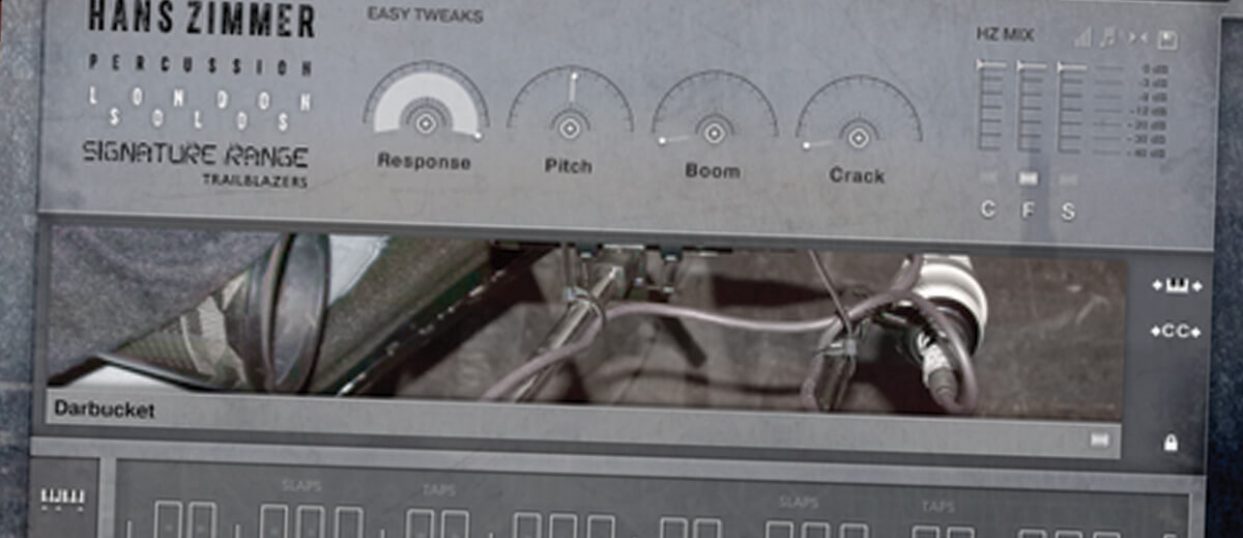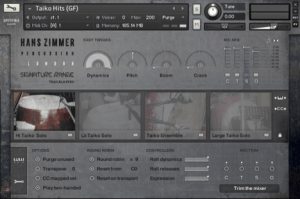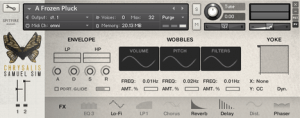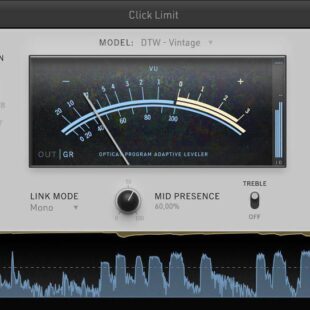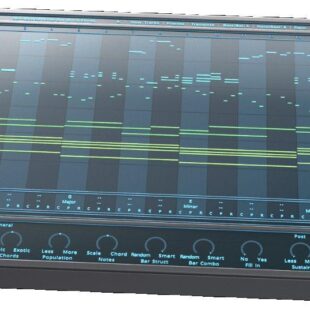Spitfire Audio Hans Zimmer Percussion and Chrysalis Samuel Sim Harp
This week we feature a double-feature review. Karl Stevens takes a close look at Spitfire Audio’s Hans Zimmer Percussion and Chrysalis Samuel Sim Harp Kontakt libraries. Enjoy.
An unlikely side-effect of the advent of personal computer-driven home recording and production is that formerly shadowy figures such as record producers and composers for film, television, and games have turned into minor celebrities. In video after video we see them interviewed, enjoy tours of their studios, watch them make beats under time constraints or with a random selection of samples and, as with many of Spitfire Audio’s recent releases, have the chance to buy sample libraries curated, created, or endorsed by them.
In this regard, Samuel Sim and Hans Zimmer represent opposite ends of the spectrum. Probably the most well-known film composer of our time, Hans Zimmer is a colossus whose work has boomed out in multiplexes for the past quarter of a century. From The Lion King, Pirates of the Caribbean, and Kung Fu Panda to the Batman Dark Knight films, Inception and, more interestingly in my opinion, Interstellar, Chappie, and The Ring, he, together with his studio-mates and former employees, largely dominates the Hollywood film-composing scene. Rumours abound that his work is done by a small army of composer-drones while he films ‘masterclasses’ in his Victorian-styled room full of priceless modular synths, collaborates with Pharrell Williams and Johnny Marr, and tours the world performing his impressive back-catalogue of blockbuster hits. Setting Hans Zimmer the brand aside for a moment, however, I think that even the most determined nay-sayer would admit that Hans Zimmer the human has brought an epicness, and a visceral intensity to the sound of recent mainstream movie music. He has done so, predominantly, with his powerful coupling of an orchestral palate with ‘rock’ instruments, synthesizers, and enormous percussion, and it is to the latter that Spitfire’s HZ 01, 02, and 03 are devoted.
HZ01, 02 & 03
The Hans Zimmer percussion library comes in three instalments HZ 01, 02, and 03. The philosophy behind the series is that, rather than create a percussion library from a software development and marketing perspective, they would instead record some of the percussion arsenals that finds regular use in Zimmer’s own projects and sample it in the way that he and his team would for a Hollywood score.
The result reveals something interesting about how they do things in Tinseltown… gigantically, it seems; in what amounts to a hard drive bonfire, the whole library clocks in at a whopping 128.2 Gig. We can rest assured, then, that whatever else we’re getting we’re getting some very high-quality samples, despite the fact that, for the size of the collection, there are not that many of them. The concern throughout, then, is with quality rather than quantity.
The GUI, which applies across the whole HZ series, allows relatively quick switching between groups of instruments (and the whole collection if one loads the ‘All In One’ patch), as well as providing some ‘easy tweak’ sliders for velocity response, pitch, ‘Boom’ (essentially a low pass filter) and ‘Crack’ (essentially a high pass filter). There is also a very effective mixer which allows one to choose between and blend close mics, rooms mics, and mics still further away. Each option/combination sounds fantastic, and this feature increases the flexibility of the libraries enormously.
HZ 01 is the largest of the triumvirate in terms of instruments (and price tag) and consists of percussion ensembles of various sorts – anvils (which sound very much more like brake drums than anvils), bass drums, bombos, boobams, buckets with darbuka, buckets with snares, buckets with nasty sounding metallic crushers, dohls, gong drums, surdos, taikos (solo as well as an ensemble), timpani (struck with soft and hard mallets as well as rods), tombeks, djuns with a newspaper laying across the head, and a couple of slightly dull sounding piatti and tamtam hits. In the interminable world of percussion instruments, this is of course a tiny array of configurations, but each has been chosen for its cinematic power and, recorded in very conspicuous stereo, they sound absolutely great. I really mean it – the sound quality is amazing, and when it comes to paying for high-fidelity samples, I’m a fussy bastard (and frequently disappointed). As a collection of sounds, therefore, HZ percussion delivers where it counts.
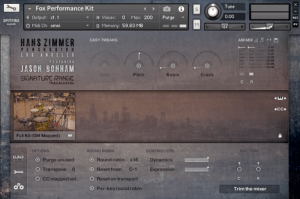 In terms of sample choices and playability, while the round robins are beautifully done and some of the larger drums feature rim hits and slaps as well as full strikes, for most of the drums there are just two live keys and perhaps a third featuring a roll (that can be given a semi-convincing de/crescendo via the mod wheel).
In terms of sample choices and playability, while the round robins are beautifully done and some of the larger drums feature rim hits and slaps as well as full strikes, for most of the drums there are just two live keys and perhaps a third featuring a roll (that can be given a semi-convincing de/crescendo via the mod wheel).
This, coupled with the limited selection of instruments, means that what one is getting in the package is essentially a small gallery of superb quality and interesting-sounding ensemble hits…‘bang’ goes one key and ‘bang’ goes the other, and, depending on the velocity you use, that’s how you play each ensemble. Having once been told by a percussionist that even a deceptively simple instrument like a guiro contains an entire universe of sound, the Hans Zimmer percussion library’s philosophy seems much more of the school that a drum goes ‘boom’ or ‘whack’ and can be captured with a few well-recorded strikes at different velocities in the centre of the head. I myself would have much preferred a wider selection of hits spread across a few keys, or even Junkie XL’s approach which spreads a drum across the whole keyboard, each key playing a different velocity strike, so that one can play the virtual instrument in a more intuitive way and with greater variation. As we will soon see, Spitfire’s new Kickstart engine may signal a promising shift of approach in this regard.
What HZ 01 may lack in terms of playable keys it certainly makes up for in terms of mixes, providing three entirely different versions of the library (accounting in part for its enormous size)– one mixed by Grammy Winner Alan Meyerson, another by the renowned Geoff Foster, and a third by Hans himself. As great as these engineers are, I suspect that most users, like me, will have a favourite sound and gravitate towards one particular set of mixes (or ‘artist elements’) as they are called. I myself strongly favour Alan Meyerson’s, which are super fat and have a nice detailed top end, whereas Geoff Foster’s approach sounds softer and more ‘classy’, while Hans Zimmer’s is darker and more ‘in your face’ with an extra dose of medium to low mid-range. If this doesn’t present enough options for you, there is a folder of additional mics in which one can open the instruments yet again, this time to create one’s own mixes, blending from among a selection of six mics in all sorts of different positions for really fine-grained tweakery. It’s worth bearing in mind, though, that even the closest mics don’t completely dry out the big spaces these instruments were recorded in, so a certain amount of reverb is always ‘baked in’ to even the softest strikes captured with the closest mics.
I’ll leap straight into HZ 03 here, as it’s very much a companion to HZ 01, featuring most of the same instruments but recorded solo instead of in ensemble form (the instruments omitted seem to be mainly those that, like the taiko, were already featured solo on HZ 01 –the ‘anvils’ being a notable exception-). Again we have the three different mixes and again we have the folder of additional mics for extra tweaking, which, in a way, is what I think HZ 03 is all about. Thus, rather than a fully independent library, I would see HZ 03 as more of a chance to separate out some of the instruments in HZ 01 and replay or recombine them in one’s own ways. It’s for those people who, after hearing the various bucket ensembles in HZ 01, are desperate to get their hands on the bucket without its various accompaniments. Like its predecessor it sounds great, but what it offers, in this way, is not new sounds as much as more control over old ones. The pricing too, with HZ 03 costing around half the amount of its forebear, seems to reflect this point of view.
HZ 02 is a different kettle of fish entirely, and features neither orchestral nor ‘world’ percussion but some meaty recordings of a rock drum kit, struck by none other than the son-of-god Jason Bonham himself, again with mixes by Alan Meyerson and Geoff Foster, and this time proliferated still more by moving the kit between three different Los Angeles locations – Sony Studios’ scoring stage, 20th Century Fox’s famous ‘Newman’ scoring stage, and a space of Zimmer’s own mysteriously known as “the cathedral” (presumably because of its sound rather than any occult function). Again it’s Alan Meyerson’s mixes that are my favourite, and again I find the number of keys on offer to ‘play’ an entire drum kit to be a bit limiting. Personally I would have found it more useful to have more of the kit recorded and playable on more keys in fewer spaces and with fewer mixes rather than vice versa, for as important as mix engineers and studio spaces are, a drum kit, to my way of thinking, is an instrument that is capable of a myriad of interesting sounds that could be of use in creating sample-based music. Given that the intended purpose of this library, though, is to give people access to Hans Zimmer’s signature film-scoring sound, the slightly ‘primary colours of rock’ drums that one gets with HZ 02 would serve well to add an aggressive and contemporary flavour to an otherwise largely orchestral palate. The library, that is to say, provides a rock drum kit with a capital ‘R’ and a small ‘d’.
As if in answer to my above complaint, HZ 02 now also comes with the Kickstart engine, an alternative GUI that allows one to create a customized player for the instruments on offer. At this stage only the ‘cathedral kit’ opens in this engine, but despite that limitation, the possibilities for customization here are huge, and address many of my earlier concerns. For every drum one can choose between an assortment of different hits and rolls, beaters, sometimes different drums or parts of the drum, and then assign them to different keys, creating whatever sort of monstrous kit one’s heart desires. By way of experiment I tried turning the massive sounding cathedral kit into something soft and sinewy, and was impressed at how, by painstakingly choosing between the right combinations of initial mix, microphone balance, strikes, mallets, and key placement, the big rock sound can be gradually transformed into a very playable drum kit with more of a delicate feel. If one is willing to spend the necessary time, therefore, this offers a great way to get the most out of the samples in the HZ 02 collection.
Finally, as the Hans Zimmer artist element of HZ 02, instead of a third, Hans Zimmer, mix of Jason Bonham’s ample hits we get a nice ‘kit’ of synth drums, created using Mr. Zimmer’s imposing banks of modular synths. These can create some ear shattering sounds and, used in conjunction with some of the more organic sounds in the library, can result in some very big hits indeed. They also sound cool by themselves, and in some ways, while they appear something of an afterthought, I could see myself getting almost more use out of these samples than the rock kits in the package. The same cannot be said of the bonus samples of Jason Bonham striking a bass drum with a doll’s head, but they do serve as a welcome reminder that experimentation is a crucial dimension of studio work.
Chrysalis Samuel Sim Harp
To say that Samuel Sim, by contrast, is a less well-known composer is a wild understatement.
But for those of us who’ve heard his lovely work in Homefires (the theme of which is super great, albeit weirdly reminiscent of Tears For Fears’ Mad World), or more recently Rowan Atkinson’s Maigret, he certainly presents a compelling new voice in the screen composition world. He has a sound that somehow manages to be at once timeless and contemporary, using classic sounds in innovative ways and, as an accomplished harp player, the notion of a sample library comprised of his hand-chosen, played, and creatively mangled harp sounds is an appealing prospect. This is especially the case because the harp has long been a bit of a secret weapon of screen composers. Its soft sound can do useful work alongside dialogue, the notes have a nice indeterminate sustain, it’s polyphonic, and it’s capable of anything from extreme sweetness to super creepy intrigue.
The library is divided into four sections, imaginatively entitled, ‘Initial Pupae’, ‘Nypmha Pedals’, ‘Metamorphosis Warps’, and ‘The Cocoonase’. The first of these contains some nice sounding, solid, studio harp samples featuring a selection of techniques (unusual spread short glisses, bowed, normale, very soft, dampened, tremolando, and octave tremolando), and with a nice array of mics to choose from and combine in different ways (six no less, including an extremely close mic, a nice condenser, and a couple of ribbons). These articulations and micings are very useful –I’m particularly fond of the ‘Super Quiet’ articulation- and the library is worth it for this section alone in my opinion. The remaining sections are basically effected and twisted-out versions of the sounds in the first section, but which come courtesy of Samuel Sim’s clever collection of pedals and feature him performing to the pedals (rather than straight-out mangling post hoc). All of the effected collections run through Spitfire’s Mercury effects engine, allowing users to control a full array of decent effects on top of those already embedded in the samples, and all feature welcome sliders that allow the user to dial in and balance the mix of the original harp with the primary effected signal, resulting in some very intriguing possibilities.
The effected sounds tend to be of the long, sustained, washy variety, often very haunting and lending themselves well to introspective and emotive moods. They are not super hi-fi to my ears, a complaint I often have when pedals are the source of effects, and because of that my own inclination would be to use them as colours in conjunction with other sounds rather than as stand-alone flavours, but I may be alone in this. Being able to mix in the dry harp signal is certainly a great feature that adds a touch of acoustic class to otherwise quite ‘new school’ sounds.
Turning from quality to quantity, whereas the initial harp samples are fairly limited in number – one will search in vain for a ‘classic’ harp glissando for instance – the number of effected sounds is generous indeed. This is good news, for as far as I’m concerned when it comes to ‘hybrid-organic’ sounds the more the merrier. It does, though, create a minor workflow issue with the organization of the library, for while technically the three effected sections are stylistically different – the ‘Nympha Pedals’ section comes with fewer samples and a slightly different GUI which allows one to mix between two pedal outputs and separate faders for the L/R balance of a dry stereo pair while the ‘Metamorphosis Warps’ and ‘The Cocoonase’ sections sport one fader each for dry and wet signal but double their number of samples by providing both plucked and tremolo versions of each sound – practically speaking I found myself having to trawl through all three effected folders to find the effected sound I was after without managing to find salient audible grounds for distinguishing between the folders. This, of course, is no more than a file-management quibble, but, when it’s being marketed as a tool for screen composers, it’s the sort of thing that can slow one down in a line of work that doesn’t really brook delays. All told, while not a comprehensive harp sample library, the extreme usefulness of harps and sustained, soft, evocative, sounds-of-indeterminate-origin for screen composing makes this an extremely handy library to have up one’s sleeve for those more downbeat moments… and, for all I know, navigation between the sections may prove easier to people who know more about moths and butterflies than I do.
Full details on both HZ1-3 and Chrysalis Samuel Sim Harp are available at Spitfire Audio www.spitfireaudio.com
By Karl Stevens

